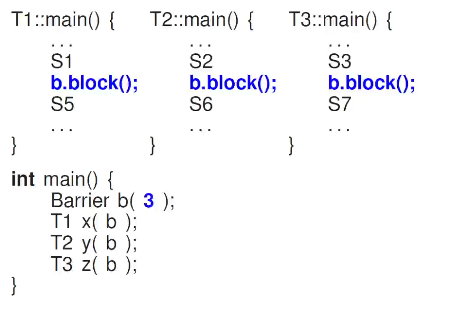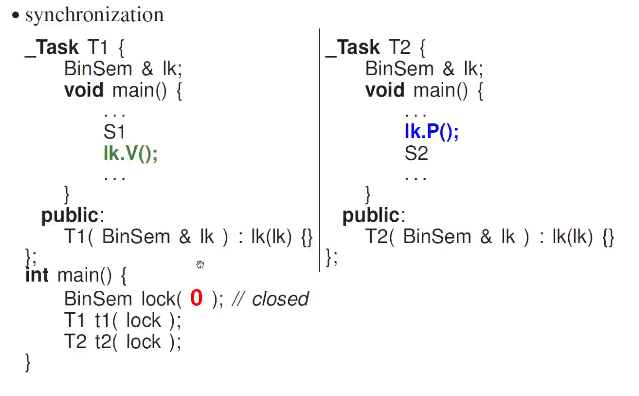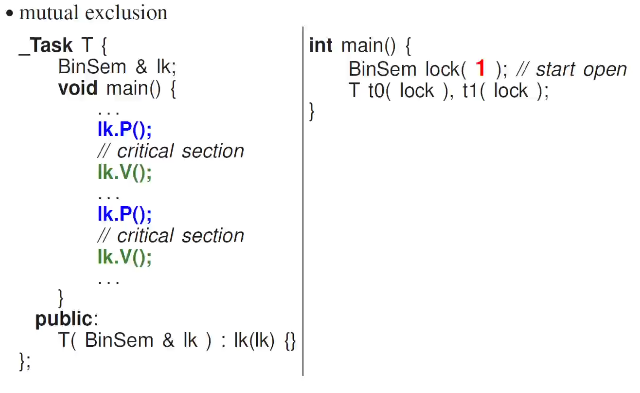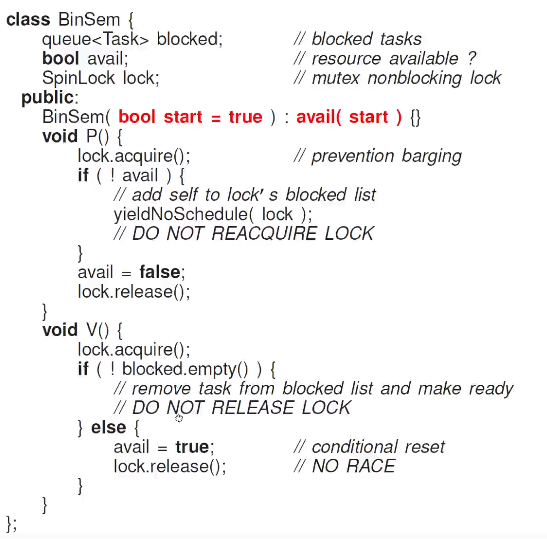6.3.3 Barrier Lock
It is syncronization lock.
It cannot be used for mutual exclusion
The barrier has some state within it.
- some counters
- some flags!
- some more information
most barriers have internal locking
EX) S1, S2, S3 must all execute before S5, S6, S7

in this example, n in b(n) is indicating how many tasks are involved.
so once b.block() is called from 3 threads, barrier will unblock them all.
The lost one to call b.block() must wake other blocked threads.

many times you want to get the results of the syncronized works.
you can make this work by having coordinator
Barrier start(N+1), end(N+1); // +1 is for coordinator
//// coordinator's job
start.block(); // wait for threads to start
//do other work
end.block(); // wait for threads to end
// sum up the result
////
//// Workers
start.block()
// do actual work
end.block()
//close down
////6.3.3.1 uBarrier implimentation
uBarrier is very complicated because it is also a full coroutine
#include <uBarrier.h>
_Cormonitor uBarrier{
protected:
void main(){ for (;;) suspend(); }
virtual void last() {resume();}
public:
uBarrier(unsigned int total);
unsigned int total() const;
unsigned int waiters() const;
void reset(unsigned int total);
virtual void block();
}unsigned int total is the number of threads involved in the race.
you can change [total] with reset, but only when no threads are on block.
it has internal syncronization lock and no barging.
Need to inherite and refine
- last
- block
members of uBarrier.
EX) matrix sum example - A4 pattern
_Cormonitor Accumulator: public uBarrier{
int total_=0, temp;
uBaseTask *Nth_ = nullptr;
protected:
void last(){
temp = total_; total_ = 0;
Nth_ = &uThisTask();
}
public:
Accumulator(int rows): uBarrier(rows){}
void block(int subtotal){ // this will be working as critical section
total_ += subtotal;
uBarrier::block();
}
int total(){return temp;}
uBaseTask * Nth() {return Nth_;}
}
_Task Adder{
int * row, size;
Accumulator & acc;
void main(){
int subtotal = 0;
for(unsigned int r=0; r<size; r++) subtotal += row[r];
acc.block(subtotal); // provide subt total
}
public:
Adder(int row[], int size, Accumulator & acc):
size(size), row(row), acc(acc) {}
};
int main(){
enum {rows = 10, cols = 10};
int matrix[rows][cols];
Adder * adders[rows];
Accumulator acc(rows); // set berrier with 'rows' number of threads
//read matrix
for(unsigned int r=0; r < rows; r++)
adders[r] = new Adder(matrix[r],cols,acc);
for(unsigned int r=0; r < rows; r++)
delete adders[r];
cout << acc.total() << " " << acc.Nth() << endl;
}You cannot use barrier with COFOR
that is because COFOR may create threads by blocks and theres no way it to tell how many of tasks are in a block.
6.3.4 Binary Semaphore
Semaphore lock()
lock.P() // to acquire
lock.V() // to release the locklock has a counter in it.
initially its 1.
P() will decrement counter
V() will increment counter.
P() on a lock of counter 0 will wait until it is V()ed.
V() on a lock of counter >0 may increment counter above 1 or throw error
this depends on implementation
EX) syncronization with semaphore

EX) mutual exclusion with semaphore

Implementation of binary semaphore

Its nearly identical with the lock implementation, but it gives an option to start the lock in either closed or open state
6.3.5 Counting Semaphore
A lock with multiple states rather than 0 or 1.
Allows N simultaneous tasks to enter critical sections.
